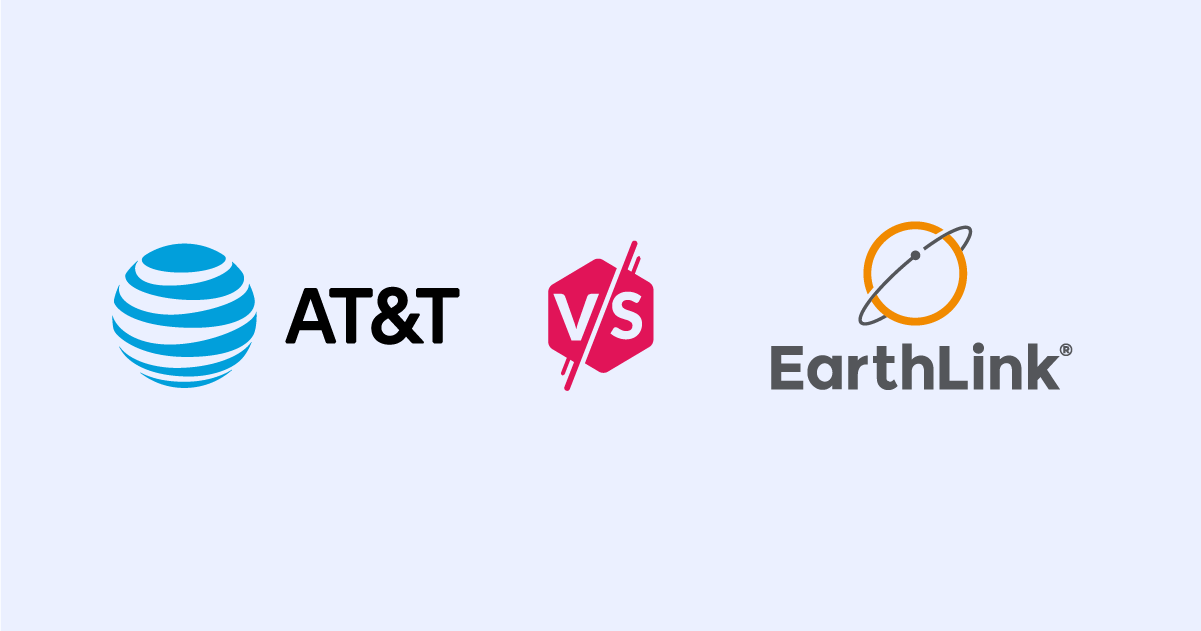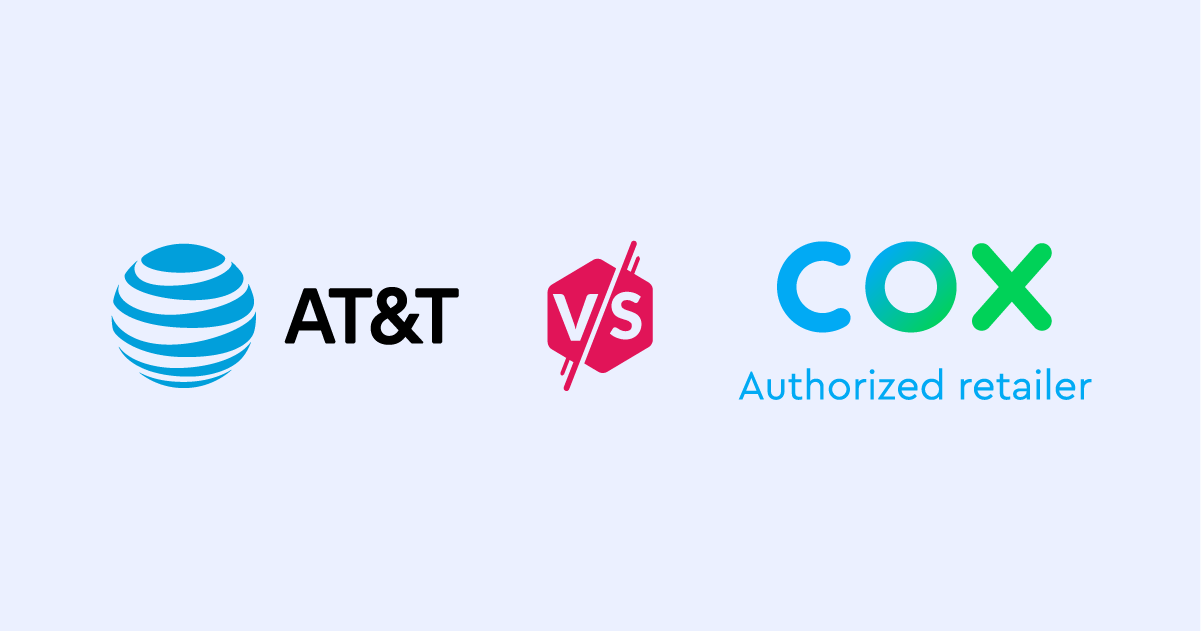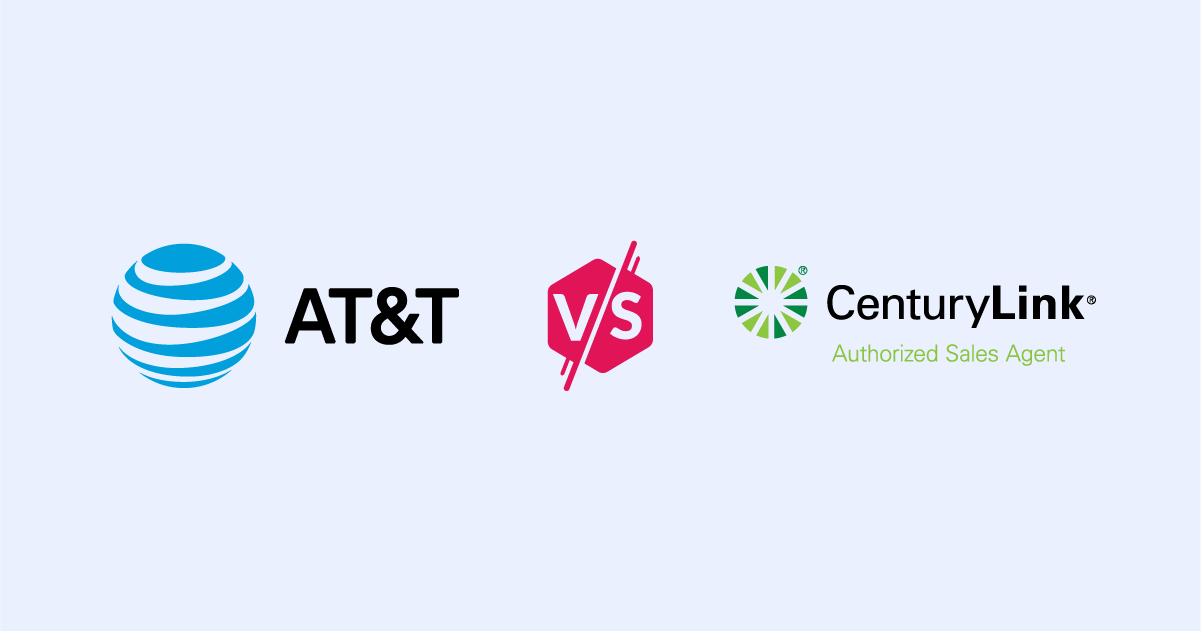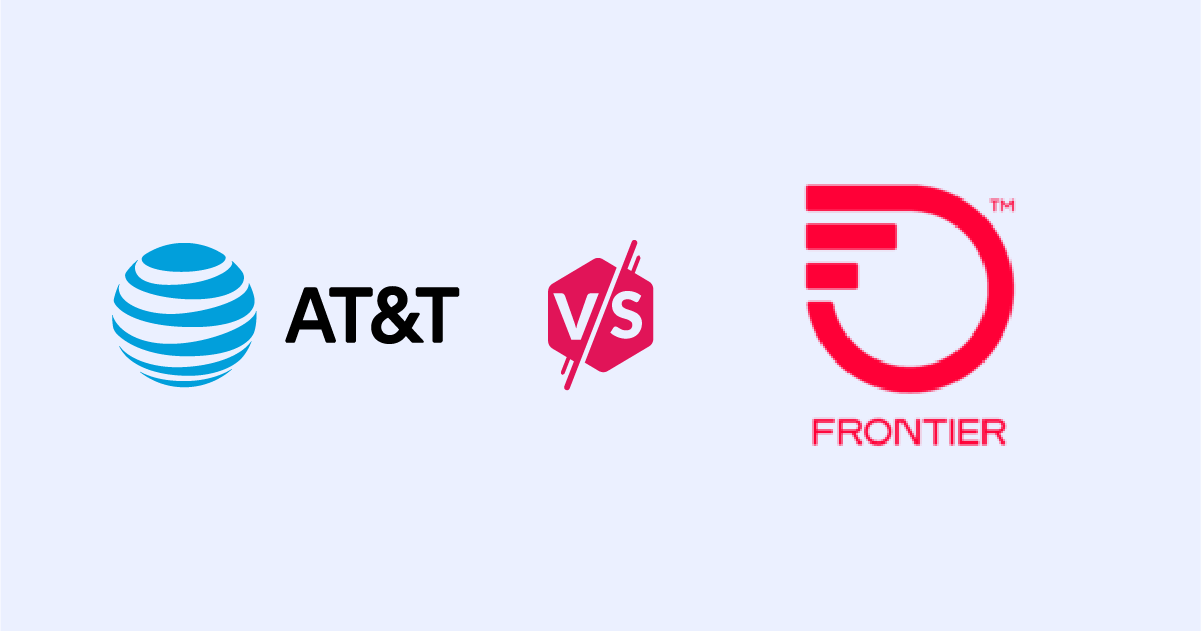AT&T vs. Mediacom
Jun 16, 2023 | Share
Provider Comparisons (Versus)
-
Best for familiesPlans start at $55.00/mo.
- Offers affordable family plans
- Delivers great performance over fiber
- High prices on the fastest plans
-
Best for high data capsPlans start at $19.99/mo.
- High data caps
- No contracts
- Massive price hikes
Data effective 10/06/22.
Jump to: Side-by-side comparison | Plans and pricing | Speeds | Fees and contracts | Equipment | Customer service | Availability | Pros and cons | Our verdict | FAQ
Bottom line
AT&T offers fiber plans with incredibly fast speeds at a good price. With a relatively high ranking in customer satisfaction nationwide, AT&T is a good choice for most people.
Mediacom gives you a lot of choices for speed. And with no annual contract, you’re never stuck with a plan that’s not working for you. But, unlike AT&T, the low prices last only 12 months. Mediacom’s price hikes range from $10 to $80, depending on the plan you choose and where you live. Ouch.
AT&T vs. Mediacom internet
|
| |
Type of service DSL, fiber, fixed wireless | Type of service Cable |
Price $55.00–$180.00/mo.* | Price $19.99–$59.99/mo.† |
Contract No contract | Contract No contract |
Download speeds 25–5,000 Mbps** | Download speeds 100 Mbps–1,000 Mbps |
Equipment fees Free for fiber plans | Equipment fees $13.00/mo. |
Installation fee $99.00 professional install, Free self-install | Installation fee $109.00 |
Customer Satisfaction 3.7/5 | Customer Satisfaction 3.6/5 |
| View Mediacom Plans |
Type of service DSL, fiber, fixed wireless | |
|
| Type of service Cable |
Price $55.00–$180.00/mo.* | |
|
| Price $19.99–$59.99/mo.† |
Contract No contract | |
|
| Contract No contract |
Download speeds 25–5,000 Mbps** | |
|
| Download speeds 100 Mbps–1,000 Mbps |
Equipment fees Free for fiber plans | |
|
| Equipment fees $13.00/mo. |
Installation fee $99.00 professional install, Free self-install | |
|
| Installation fee $109.00 |
Customer Satisfaction 3.7/5 | |
|
| Customer Satisfaction 3.6/5 |
|
| View Mediacom Plans |
Data effective 02/14/23. Not all offers available in all areas.
*Plus taxes. Price after $5/mo Autopay & Paperless bill discount (w/in 2 bills). Monthly State Cost Recovery Charge in TX, OH, NV applies.
**Internet speed claims represent maximum network service capability speeds and based on wired connection to gateway. 1GIG speeds avail. to new customers with the latest router (“BGW320”) and recommended setup. For 5 GIG speed, single device wired speed maximum 4.7 Gbps. Actual customer speeds may vary based on a number of factors and are not guaranteed. For more information, go to www.att.com/speed101.
†For the first 12 months. Plus, activation, installation and monthly modem rental fees.
AT&T vs. Mediacom packages and pricing
Both AT&T and Mediacom have a lot of the same perks and a lot of the same drawbacks. Both of them offer a lot of choices in terms of plans, but both have a lot of hidden costs buried in the fine print.
The differences between the two are subtle but important. Let’s take a closer look at them side by side.
AT&T packages
| Package | Price | Speed* | Internet type |
|---|---|---|---|
| AT&T Internet up to 75 | $55.00/mo.* | Up to 75 Mbps | DSL |
| AT&T Internet up to 100 | $55.00/mo.* | Up to 100 Mbps | DSL |
| Internet 100 | $55.00/mo.† | 100 Mbps | Fiber |
| Internet 300 | $55.00/mo.† | 300 Mbps | Fiber |
| Internet 500 | $65.00/mo.† | 500 Mbps | Fiber |
| Internet 1000 | $80.00/mo.† | 1,000 Mbps‡ | Fiber |
| Internet 2000 | $110.00/mo.† | 2,000 Mbps‡ | Fiber |
| Internet 5000 | $180.00/mo.† | 5,000 Mbps‡ | Fiber |
| AT&T Fixed Wireless Internet | $59.99/mo. | 25 Mbps | Fixed wireless |
| AT&T Internet Air | $55.00/mo. | 40–140 Mbps | Fixed wireless/5G |
*for 12 mos, plus taxes & equip fee. $10/mo equip fee applies. Incl 1TB data/mo. $10 chrg for each add’l 50GB (up to $100/mo).
†Plus taxes. Price after $5/mo Autopay & Paperless bill discount (w/in 2 bills). Monthly State Cost Recovery Charge in TX, OH, NV applies.
‡Internet speed claims represent maximum network service capability speeds and based on wired connection to gateway. 1GIG speeds avail. to new customers with the latest router (“BGW320”) and recommended setup. For 5 GIG speed, single device wired speed maximum 4.7 Gbps. Actual customer speeds may vary based on a number of factors and are not guaranteed. For more information, go to www.att.com/speed101.
AT&T has some really affordable packages that offer a lot of speed—you can even get an insanely fast 5,000 Mbps plan for some of the fastest internet speeds in the country. You can cancel at any time on a fiber plan without worrying about early termination fees.
Another important point is that while AT&T is available in many areas, very few of these areas are wired for its fiber connections. If you’re looking only at its slower DSL plans, suddenly, its selection of packages isn’t quite as enticing.
Mediacom packages
| Package | Price | Speed | Internet type | Data cap |
|---|---|---|---|---|
| Internet 100 | $19.99/mo.* | 100 Mbps | Cable | 200 GB |
| Internet 200 | $39.99/mo.* | 200 Mbps | Cable | 1,000 GB |
| Internet 400 | $49.99/mo.* | 400 Mbps | Cable | 2,000 GB |
| Internet 1 GIG | $59.99/mo.* | 1,000 Mbps | Cable | 6,000 GB |
| Package | Internet 100 |
| Price | $19.99/mo.* |
| Speed | 100 Mbps |
| Internet type | Cable |
| Data cap | 200 GB |
| Package | Internet 200 |
| Price | $39.99/mo.* |
| Speed | 200 Mbps |
| Internet type | Cable |
| Data cap | 1,000 GB |
| Package | Internet 400 |
| Price | $49.99/mo.* |
| Speed | 400 Mbps |
| Internet type | Cable |
| Data cap | 2,000 GB |
| Package | Internet 1 GIG |
| Price | $59.99/mo.* |
| Speed | 1,000 Mbps |
| Internet type | Cable |
| Data cap | 6,000 GB |
*For the first 12 months. Plus, activation, installation and monthly modem rental fees.
Mediacom’s biggest attraction is its rock-bottom prices on its basic internet plan (at least at first) combined with its huge data allowances on its more expensive plans. Its selection of plans allows you to avoid wasting money on unnecessary features by choosing the precise speed that you need—at least to begin with.
As with AT&T, the devil’s in the details. All four plans go up in cost after the first year, but the standard rate depends on where you live. The 1 GIG plan, for instance, starts at $60 per month, but after a year, your cost increases to $130 in eight states and $140 in Delaware.
Fortunately, unlike AT&T, Mediacom doesn’t lock you into an annual contract, which means that you can bail at any time. Its cable network is also a lot more reliable than DSL, which is another big advantage.
While a 6,000 GB data cap is probably one of the highest you’re ever going to see, it’s worth remembering that many providers offer unlimited data plans at much lower prices. Plus, you can’t pay extra to get unlimited data with Mediacom as you can with Xfinity.
AT&T vs. Mediacom: Who has the fastest internet speed?
Internet speeds
Of the two, AT&T wins the speed race with its Internet 5000 plan, which gives you 5,000 Mbps upload and download speeds. But it’s also an expensive plan, and most internet users will be just fine with 1,000 Mbps speeds or less.
Both AT&T and Mediacom offer plans with 1,000 Mbps (1 Gbps) download speeds. AT&T is cheaper after Mediacom’s 12-month pricing and is more reliable too, with the added benefit that it gives you gigabit upload speeds—something you won’t get from a cable provider like Mediacom.
Mediacom’s cable internet is, however, much faster and more reliable than AT&T’s DSL internet, so in areas where AT&T offers only DSL connections, Mediacom reigns supreme in terms of dependable speeds.
Test your speed:
Curious to see how fast your internet connection is right now? Use our speed test to find out.
Internet types
AT&T offers both fiber and DSL plans. Fiber is the best internet connection available because it’s both fast and reliable. It also offers symmetrical upload speeds, which means that if you stream video or upload large files, those uploads will benefit from the same gigabit speeds that your downloads do.
The only real downside is that fiber networks are still available only in a very limited number of places.
DSL hits a max speed of only 140 Mbps, and depending on the distance between your house and the provider, it could be much less than that. Nowadays, phone lines are often laid with DSL in mind, which can improve speeds, but DSL is still one of the slower options for broadband internet.
Mediacom offers only one type of internet: cable. Its cable speeds range between 100 Mbps to 1,000 Mbps, with its top speeds rivaling those of fiber networks. The downside of cable networks is that, unlike fiber, they depend on powered amplifiers to deliver data across distances, so if they fail, you will experience a slowdown or no connection at all.
Despite these drawbacks, cable is still much faster and more reliable than DSL, often making it the best choice in areas without fiber coverage.
AT&T vs. Mediacom fees and contracts
Nobody likes surprises when they’re paying their bills, and both of these providers have a lot of hidden fees tucked away in their fine print. Here’s a roadmap to help you navigate through these unexpected costs.
Internet fees
AT&T fees
| Fees | Amount | More info |
|---|---|---|
| Modem rental | $10 for DSL | Learn more |
| Installation | $99 professional installation, Free self-installation | Learn more |
| Activation | $35 | Learn more |
| Declined payment | Up to $30 | Learn more |
| Late fee | Up to $10 | Learn more |
| Cancellation fee | $180 (prorated ETF) | Learn more |
| Taxes | Cost may vary | Learn more |
Data as of 02/14/2023.
AT&T has a lot of upfront costs, but it does allow you to install your equipment yourself, so professional installation is optional. Its cancellation fees are also prorated, so you won’t necessarily have to pay the full amount if you decide to cancel your contract.
Mediacom fees
| Fees | Amount | More info |
|---|---|---|
| Modem rental | $13.00/mo. | Learn more |
| Installation | $109.99 | Learn more |
| Activation | $10.00 | Learn more |
| Declined payment | Cost may vary | Learn more |
| Late fees | $10.00 | Learn more |
| Cancellation fee | $120.00–$240.00* | Learn more |
| Taxes | Cost may vary | Learn more |
Data as of 10/06/22.
* One- to three-year agreements only.
Mediacom requires professional installation, so you can’t install it yourself. Fortunately, if you order online, it’ll waive your installation fee.
One of the big advantages of going with Mediacom is that you can typically avoid the annual contracts that you get with AT&T, which can be a lifesaver once those price hikes hit you. If you do sign a contract with Mediacom for a year or more, make sure you don’t do it lightly, as the early termination fees are pretty steep.
Bundled packages
Mediacom offers bundled packages with internet, TV, and phone all in one. Bundling your internet plan can save you money by giving you lower monthly prices, but it can also end up costing you money if you don’t read the fine print.
AT&T used to offer bundles with DIRECTV or AT&T TV, but those offers are no longer available. You can still get DIRECTV, but you’ll need to order them as separate services, so you won’t get a deal on price.
Mediacom also provides bundles with TV service, offering over 170 channels. As with its standard internet service, its bundled plans go up in price not just after the first year but every year until you hit the standard rate.
That means that if you go with their Xtream Silver 200 plan, you’ll be paying $199.98 a month after four years. Fortunately, you don’t have an annual contract, so you can change your mind at any time.
Internet contracts
AT&T’s internet plans come with no annual contracts, so you can cancel any time. Mediacom does monthly contracts, which makes it much easier to switch providers without incurring penalties.
Editor’s pick:
Both AT&T and Mediacom have a lot of hidden fees to tiptoe around, but we prefer Mediacom’s month-to-month plans that give you the flexibility to hopefully avoid most of them.
AT&T vs. Mediacom equipment
Renting a modem and router
Renting your equipment from your provider saves a lot of time and hassle. Additionally, some of the features of bundled plans, such as on-demand video, require specialized equipment that you can get only from your provider.
Both AT&T and Mediacom have very low monthly equipment rental fees, which also makes this an attractive option. If you plan on staying with the same provider for two years or more, buying the equipment will probably save you money in the long run, but it also makes it more difficult for you to switch providers, as you’ll end up buying a new router every time you switch.
We recommend using your provider’s equipment. It will be faster and easier to resolve tech issues, and you won’t have to deal with connection cutoffs and other glitches that may come when you’re using something that the company isn’t already familiar with.
Buying a modem and router
You can buy a modem and router yourself if you’d prefer to pick something that’s up to your personal specifications. Owning your router gives you more control over security settings and advanced features. It’s also helpful if you’d like to boost your Wi-Fi signal to a wider reach.
AT&T vs. Mediacom customer ratings
| Overall | Reliability | Customer service | Speed | Price | |
|---|---|---|---|---|---|
| AT&T | 3.7 | 3.7 | 3.7 | 3.8 | 3.5 |
| Mediacom | 3.6 | 3.6 | 3.6 | 3.9 | 3.1 |
* Rating based on a five (5) point system used in our customer satisfaction survey. Higher is better.
AT&T ranks fourth in overall satisfaction among the 13 national internet providers in our latest customer satisfaction survey. Its strongest rating is in price satisfaction, with a score better than the national average in terms of no price hikes. AT&T ranks in the top five across all other categories, including speed satisfaction, where it falls slightly behind Mediacom in meeting speed needs and delivering advertised speeds.
Mediacom ranks right in the middle of the 12 other national internet providers in overall satisfaction. Its weakest point is in price satisfaction, as it has higher post-promo prices in some states than it does in others. Speed satisfaction is its strongest rating, with the best score out of all the providers in speeds that “always” or “usually” meet the customer’s needs.
AT&T vs. Mediacom installation and setup
Both Mediacom and AT&T offer professional installation for a similar price. The biggest difference between the two is that AT&T offers a self-installation option, which means if you’ve got a bit of tech savvy, you might be able to save yourself a decent amount of upfront cost.
AT&T vs. Mediacom availability
AT&T can be found in much of the US. Its network covers an area that spans from Florida to Texas and as far north as Wisconsin and Michigan. It also covers large parts of California and Nevada, though it has some noticeable gaps in the northeastern and western United States.
Mediacom has a much smaller coverage area, which is focused around the Midwest. The important thing to remember is that while most of AT&T’s service area provides DSL connections with fiber networks available only in large population centers, Mediacom’s high-speed cable internet is available in every area they service.
To see if either AT&T or Mediacom is available in your area, enter your ZIP code in the search bar below.
Find internet providers in your area.
Pros and cons
Pros
- Affordable prices
- High-speed fiber in some areas
- Self-install option available
Cons
- Limited fiber availability
- Small data cap for fixed wireless
Pros
- Reliable cable internet
- Four plans to choose from
- Free installation if you sign up online
Cons
- Price hikes after the first year
- Very limited availability
Our verdict: Go with AT&T fiber if it’s available.
When it comes to AT&T versus Mediacom, we like AT&T the best because it’s got fast plans and fairly high ratings for customer satisfaction across the board. It’s also got a blindingly fast and reliable network . . . in some areas. If DSL is all that it offers in your area, it’s still worth checking out. But if speeds up to 100 Mbps won’t cut it, Mediacom might be the better option for you if it’s available.
With a lot of different options and the ability to jump ship at any time, Mediacom can be a good choice if you’re willing to dance with them. Just remember that one misstep can be very expensive.
Find internet providers in your area.
AT&T vs. Mediacom FAQ
Is AT&T internet any good?
AT&T Internet is a great choice for people looking for fast fiber-optic speeds and affordable prices. It’s an incredibly fast option if you happen to live in an area where AT&T’s gigabit fiber network is available—you can even tap into 2,000 Mbps or 5,000 Mbps speeds.
Is Mediacom internet any good?
Mediacom is a good choice for people who want a lot of flexibility and options in their plan.
It’s also a great choice for people who need to download massive amounts of data every month, though there are many other providers (including AT&T) that have plans with unlimited data. Still, you’d really have to try to pass your data caps with Mediacom’s more expensive plans, so it might be an option to consider.
Mediacom internet comes with some pretty hefty price hikes after the first year, but there are no annual contracts, so you’re free to switch providers as soon as it gets too pricey for you.
Who has the fastest internet: AT&T or Mediacom?
AT&T has the fastest internet speeds, with the fastest plan topping out at a stunning 5,000 Mbps. That’s the fastest internet plan from any major provider in the entire country.
Both of these providers also offer gigabit internet plans with speeds up to 1,000 Mbps (1 Gbps), but AT&T delivers its gigabit plan over an ultra-reliable fiber-optic network. Cable internet can deliver gigabit speeds, but it is often slowed by heavy traffic, which leaves AT&T Fiber as the clear winner.
In areas where AT&T offers only DSL, however, even the fastest DSL connection won’t be able to compare with Mediacom’s cable internet.
Author - Peter Christiansen
Peter Christiansen writes about satellite internet, rural connectivity, livestreaming, and parental controls for HighSpeedInternet.com. Peter holds a PhD in communication from the University of Utah and has been working in tech for over 15 years as a computer programmer, game developer, filmmaker, and writer. His writing has been praised by outlets like Wired, Digital Humanities Now, and the New Statesman.
Editor - Cara Haynes
Cara Haynes has been editing and writing in the digital space for seven years, and she's edited all things internet for HighSpeedInternet.com for five years. She graduated with a BA in English and a minor in editing from Brigham Young University. When she's not editing, she makes tech accessible through her freelance writing for brands like Pluralsight. She believes no one should feel lost in internet land and that a good internet connection significantly extends your life span.




